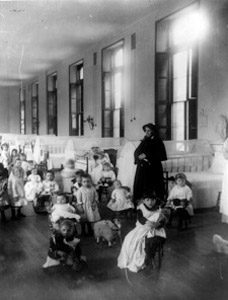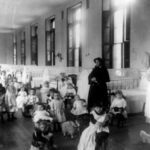In Post-Civil War New York, some 30,000 homeless children wandered the streets. Catholic sisters provided alternatives to failing public alms-houses.
The babies showed up at the front door of the house, in a variety of outfits and packages. Some were dressed in rags, some in fine clothing. Some had a dollar pinned to their blanket, all their mother could afford. Sometimes notes were left. One mother wrote:
If in years to come I could hear that he has a home and some friends, I could die in peace. If I should not hear this, it would haunt me to the day of my death. Please, in God’s names, remember the last request of a heart broken mother and be good to my dear little Charley…
Another wrote: “This little child has suffered since she was born…. My husband is dead and I have nobody to help me.” One child was sent by a “wronged and heartbroken mother with no one to take an interest in her but God.”
In the fall of 1869, a group of Catholic nuns rented a house on East Twelfth Street in Manhattan’s Greenwich Village to care for the unwanted and the abandoned children of New York. Their leader was a determined, compassionate woman named Sister Mary Irene Fitzgibbon. Over the course of the following year, over a thousand infants were dropped at their doorstep. These Sisters of Charity, as they were known, were meeting a major social need of the day.
Described by her biographer as a “gritty and tough spirit,” Catherine Rosamond Fitzgibbon was born in England to Irish parents. As a child her family came to America, settling in downtown Brooklyn. At St. James School, she studied under the Sisters of Charity, the community she would enter. In 1849, she nearly died during one of the many cholera epidemics that swept nineteenth century New York. The illness proved to be a life-changing experience, and the following year she joined the Sisters. At age 27, as what was then called a “late vocation,” Catherine took the name Sister Mary Irene. For nearly twenty years, she taught at St. Peter’s School on Barclay Street. (Founded in 1800, St. Peter’s was the first Catholic school in New York State.) But she found increasingly drawn toward a different kind of apostolate than education.
In the years following the Civil War, it was estimated, some thirty thousand homeless children wandered the streets of New York. Some were unwanted pregnancies, most the children of parents unable to provide for them. Stories of infanticide were common in the newspapers. One paper commented: “Day by day the papers tell of little human waifs thrown into areas, or left on doorsteps, or worse far, and more to be deplored, flung lifeless into vacant lots like garbage or refuse matter.”
Stories like these touched the heart of Sister Irene, who decided to do something about it. She gave up her teaching position to start a home for the “countless numbers of abandoned babies” in the city. She asked permission from her religious superiors to start a home for these unwanted children. While alternatives did exist, these were woefully inadequate. At the Almshouses on Blackwell’s Island in the East River, many children often died from lack of care.
Care, a deep and personal care rooted in Christian charity, was going to be the keystone of this new operation. In time, The New York World would write: “The infants were not merely abject numbers to her, but precious individuals who deserved complete dignity and loving care.” The Sisters started with five dollars to their name. They ate their first meal on the floor using old newspapers for a table cloth. At the front door, they placed a crib for mothers to leave their infants. A sign on the front door read “The Home for Foundlings.”
A report by state officials described the “home feeling” that was “cultivated with the utmost assiduity.” The report continued:
The foundlings exhibit toward the Sisters the confiding love of children toward their mothers; and are, in turn, met by an affection, spiritualized and strengthened by religion, which follows them through life, and, it is hoped, compensates them in a great degree, for the loss of natural maternal love.
The New York World asked: “Can the citizens of New York ever repay the Sisters of Charity the debt they owe for the establishment of this great charity?”
Mother Irene, her biographer writes, “was never happy . . . unless she was planning a new building or a new charity.” Poor health caught up with her, and at age 73, she died of heart disease. Thousands turned out for her funeral. The New York Herald commented: “Never before in the history of New York has such a tribute been paid.” The New York Times hailed her as “that great benefactor of humanity.”
Today the New York Foundling is one of the city’s oldest and most successful child welfare agencies. It continues its mission to society’s least and smallest, to “abandon no one.” Its work with society’s “most vulnerable,” reaching some 13,000 each years in New York and Puerto Rico, continues to be rooted in the determined compassion that motivated its foundress nearly 150 years ago. And it all began with five dollars, a crib, and an empty apartment building in the Village.
See also the Orphan Train
Tags: New York, NY Foundling, Sisters of Charity


